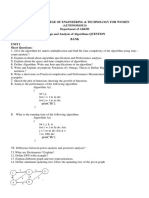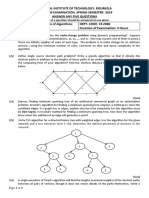0% found this document useful (0 votes)
29 views3 pagesDaa
The document outlines various algorithmic problems and techniques, including the 0/1 Knapsack problem, Job Sequencing with deadlines, Greedy methods, and Dijkstra's algorithm. It also discusses NP-hard and NP-complete classes, the Travelling Salesman problem, Optimal Binary Search Trees, and minimum cost spanning trees using Kruskal's and Prim's algorithms. Each problem is accompanied by specific examples and requests for optimal solutions or explanations of algorithms.
Uploaded by
SaisrikarCopyright
© © All Rights Reserved
We take content rights seriously. If you suspect this is your content, claim it here.
Available Formats
Download as PDF, TXT or read online on Scribd
0% found this document useful (0 votes)
29 views3 pagesDaa
The document outlines various algorithmic problems and techniques, including the 0/1 Knapsack problem, Job Sequencing with deadlines, Greedy methods, and Dijkstra's algorithm. It also discusses NP-hard and NP-complete classes, the Travelling Salesman problem, Optimal Binary Search Trees, and minimum cost spanning trees using Kruskal's and Prim's algorithms. Each problem is accompanied by specific examples and requests for optimal solutions or explanations of algorithms.
Uploaded by
SaisrikarCopyright
© © All Rights Reserved
We take content rights seriously. If you suspect this is your content, claim it here.
Available Formats
Download as PDF, TXT or read online on Scribd
/ 3


























































